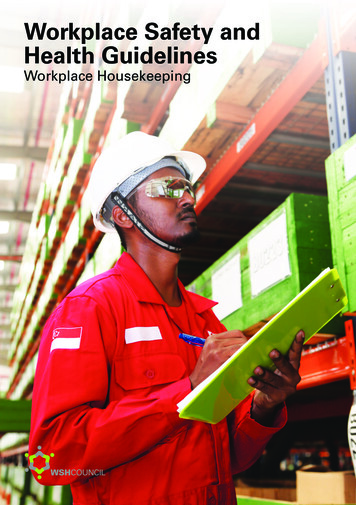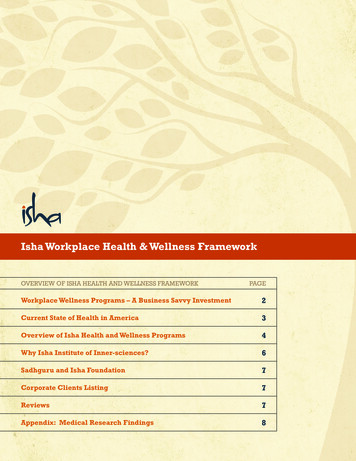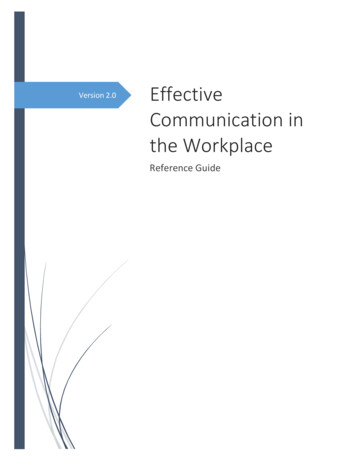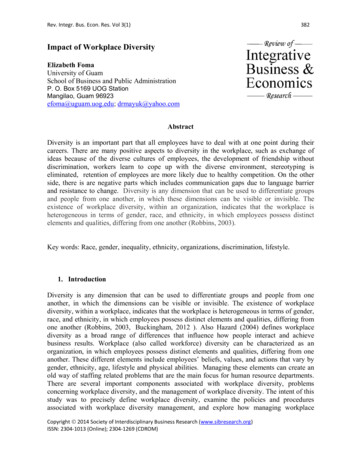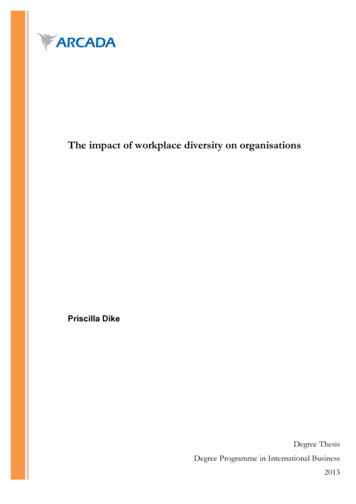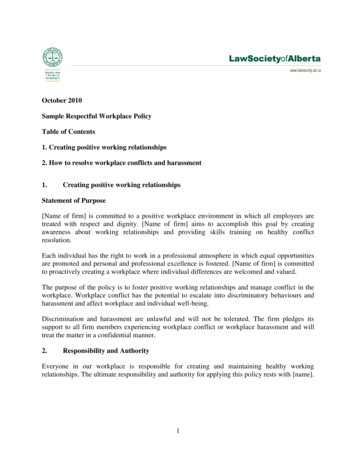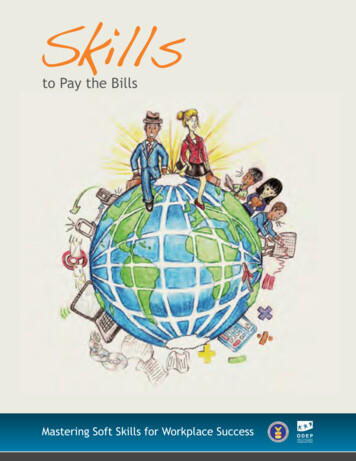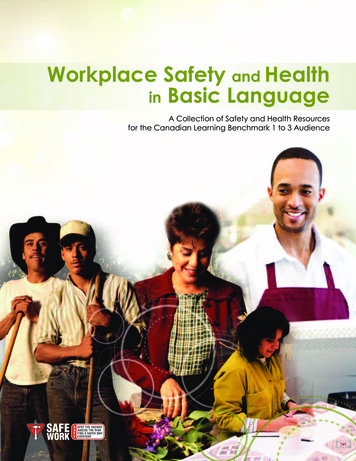
Transcription
Workplace Safety and Healthin Basic LanguageA Collection of Safety and Health Resourcesfor the Canadian Learning Benchmark 1 to 3 Audience
ContentsAcknowledgements . . . . . . . . . . . . . . . . . . . . . . . . . . . . . . . . . . . . . . . . . . . . . . . . . . . . . . . . . . . . . . . . . . . . . . . . 6Artwork6Module 1: Introduction to Safety 1 to 3 . . . . . . . . . . . . . . . . . . . . . . . . . . . . . . . . . . . . . . . . . . . . . . . . . . . . . . 7About the Kit8When Should I Introduce Workplace Safety in the Class?9Is the Material Relevant to the Class?9How to Navigate the Kit101.1 Background InformationWhy is safety training important?Cultural taboos1010101. 2 Classroom ActivitiesActivity 1.2.1: What is relevant to your students?11111. 3 Visuals1.3.1 People at work1.3.2 Dressed for work121212Module 2: Basic Vocabulary for Safety . . . . . . . . . . . . . . . . . . . . . . . . . . . . . . . . . . . . . . . . . . . . . . . . . . . . 15Objectives162.1 Background Information162.2 Suggested Classroom Activities2.2.1 Reading Danger Signs2.2.2 Activities Introducing Basic Safety Vocabulary2.2.3 Workplace Injuries (Dialogues)161617172.3 HandoutsActivity 2.3.1: Danger signsCards for 2.2.3 Types of IncidentsWorkplace Injuries Flashcards 2.2.418182121Module 3: Watching for Hazards . . . . . . . . . . . . . . . . . . . . . . . . . . . . . . . . . . . . . . . . . . . . . . . . . . . . . . . . . . . . . 3Outcomes243.1 Background Information243. 2 Classroom ActivitiesActivity 3.2.1: Hazards, things that can hurt youActivity 3.2.2: Slips and tripsActivity 3.2.3: Reporting a hazard (role play)Activity 3.2.4: A personal hazard storyActivity 3.2.5: Machines with moving parts2424252525253
3.3 Hazard HandoutsHandout for Activity 3.2.1: Hazards, small cardsHandout for Activity 3.2.2: Match the danger with the danger signHandout for Activity 3.2.3: Identifying fall hazardsExercise for Activity 3.2.4: Slips and trips3.2.5 A Personal Hazard StoryMachines with Moving Parts262628293031323.4 Hazards Visuals3.4.1 Hazards Flash Cards3.4.2 Workplace Injuries3.4.3 Effects of Hazardous Materials3.4.4 Photo Collection3333363738Module 4: Hazardous Materials and WHMIS . . . . . . . . . . . . . . . . . . . . . . . . . . . . . . . . . . . . . . . . . . . . . . . . . 1Objectives424.1 Background InformationThe WHMIS System has 4 Components42424.2 Classroom ActivitiesActivity 4.2.1: Making Hazardous Materials postersActivity 4.2.2: How poison enters your bodyActivity 4.2.3: Feeling illActivity 4.2.4: Personal Protective Equipment for Hazardous MaterialsActivity 4.2.5: Reading a WHMIS labelActivity 4.2.6: Talking about toxic effectsActivity 4.2.7: Listening to a WHMIS story45454747474849494.3 HandoutsHandout for Activity 4.2.3: Feeling IllHandout for Activity 4.2.7: A WHMIS storyHandout for Activity 4.2.5: Reading a WHMIS label505051534.4 Visuals for Hazardous Materials and WHMISWHMIS Symbols4 Ways into the BodyPersonal Protective Equipment for Hazardous Materials54546062Module 5: Working Safely . . . . . . . . . . . . . . . . . . . . . . . . . . . . . . . . . . . . . . . . . . . . . . . . . . . . . . . . . . . . . . . . . . 64Outcomes655.1 Background Information655.2 Classroom ActivitiesActivity 5.2.1: Dressing for safety65654
Activity 5.2.2: Ethnic DressActivity 5.2.3: Body Parts and InjuriesActivity 5.2.4: Personal Protective EquipmentActivity 5.2.5: Card GamesActivity 5.2.6: Fire SafetyActivity 5.2.7: Using a Fire ExtinguisherActivity 5.2.8: Use Machines with Care5.3 HandoutsHandout for Activity for 5.2.1: Dress Regulations for Packing FloorHandout for Activity for 5.2.2: Ethnic Dress and Safety (Reading)Handout for Activity 5.2.3: Body Parts and InjuriesHandout for Activity 5.2.4: What PPE are these workers wearing?5.2.4 Review: Personal Protective EquipmentHandout for Activity 5.2.6: Fire SafetyHandout for Activity 5.2.7: Using a Fire Extinguisher5.4 Working Safely Visuals5.4.1 Dress for safety cards5.4.2 PPE posters5.4.3 Card games with PPE5.4.4 Fire Safety5.4.5 Machine Guarding poster5.4.6 Hazard Alert 05106Module 6: Safety in Light Industry . . . . . . . . . . . . . . . . . . . . . . . . . . . . . . . . . . . . . . . . . . . . . . . . . . . . . . . . . 109Objectives1106.1 Background Information1106.2 Classroom ActivitiesActivity 6.2.1: More discussion of HazardsActivity 6.2.2: Warning SymbolsActivity 6.2.3: Reporting a Hazard to your SupervisorActivity 6.2.4: Giving Instructions about Ergonomics (role play)Activity 6.2.5: An Incident Report Form1111111111121121136.3 Industry HandoutsHandout for Activity 6.2.2: Warning SymbolsFlashcards for Activity 6.2.3: Reporting a Hazard to your SupervisorErgonomics Posters for Activity 6.2.4Incident Report Form for Activity 6.2.51141141161171206.4 Visuals6.4.1 Photos from Industry6.4.2 Industry Warning Symbols121121122Resources . . . . . . . . . . . . . . . . . . . . . . . . . . . . . . . . . . . . . . . . . . . . . . . . . . . . . . . . . . . . . . . . . . . . . . . . . . . . . . . . . . 1255
AcknowledgementsThe kit and the activity suggestions were compiled and written by Lisa Petit. For theirsupport and assistance, many thanks go to the following people:Anna Bird at Adult Language Training Branch,Manitoba Department of Labour and Immigration.Judy Fraser at Workplace Safety and Health,Manitoba Department of Labour and Immigration.Carol Hawkins, and the supportive members of MISI,The Manitoba Immigrant Safety Initiative.Melanie Olfert and Nuo Yang.Lisa Allard, Lisa Reichert and Carla Woods at Work Start.Gail Foote-Leylek at St. Boniface Hospital.James Morden and Paul Urish at Palliser Furniture.Linda Lalonde and Margaret Ko at International Centre.Sylvia Thiessen, English at Work Coordinator, Pembina Valley.Linda Karras, EAL workplace instructor.ArtworkMany of the photos used in this Resource come from the MISI (Manitoba Immigrant SafetyInitiative) collection and were taken at Palliser Furniture.Others were provided by SAFE Manitoba and Health and Safety 101,Workplace Safety and Insurance Board, Ontario.Photos for People at Work are from Career Destinations Manitoba.Another source throughout has been Microsoft Office Clipart.Hazard Alert stories and illustrations are courtesy of Worksafe BC.Story sequence artwork is by Lisa Petit.The Health and Safety 101 Resource Guide is funded by Citizenship and ImmigrationCanada through the Manitoba Immigrant Integration Program.6
module 1Introduction to Health and safety 1 to 3Workplace Safety and Health in Basic Language I 7
Module 1: Introduction to Healthand Safety 1 to 3About the KitIn late 2008, the Manitoba Immigrant Safety Initiative (MISI)collaborated with Adult Language Training (Immigration,Settlement and Multiculturalism Division, Manitoba Labourand Immigration) to assemble a database of safety andhealth resources for immigrant workers. This Resource can befound at www.immigratemanitoba.ca.The search uncovered few EAL materials at lower levels(Canadian Language Benchmark levels 1 to 3), thatfocused on Safety and Health issues. This kit, funded by AdultLanguage Training, is an attempt to address that need.The kit provides teachers of CLB Levels 1-3 with WorkplaceHealth and Safety materials appropriate for use in the classroom. The manual provides anoverview of the materials for lesson planning and the .pdf format allows you to adapt thehandouts and visuals to your needs.The kit includes six modules, usually containing 4 sections:Section 1: Background Information for the instructorSection 2: Suggested Classroom Activities and HandoutsSection 3: Handouts referenced to the activitiesSection 4: Large coloured visuals (posters, flash cards, game cards, etc.)Downloading the manual to your hard drive will give you full access to the materials. Thematerials are in .pdf format. Using the Select tab, you can copy text and graphics into aWord document which will allow you to adapt it to the needs of your class.The kit focuses on lower skilled jobs at the entry level. The samples include such jobs ashousekeeping (hospital and hotel), fast food, warehousing, construction or auto mechanic.8
Beginners benefit a lot from good visual supports. The kit provides a variety of printable,copiable materials in different formats. The pictures can be augmented by copying themto a blank page, then clicking and dragging to expand to poster or flash card size. If youwant to use the pictures in a smaller format, copy and shrink them to the size you need.Large photos can be printed and stored in binders. Flash cards and cardsfit into small ziplock bags or in small (cheap) photo albums.Smaller cards used for review and games can also be laminated and kepton a ring. A handy review for students to keep in their pockets.(Photo: Sylvia Thiessen)When Should I Introduce Workplace Safety in the Class?This material will be useful with learners who are currently working or are actively lookingfor work. Use only materials that are relevant to the learners’ personal interest. For example,some personal protective equipment is used only in a manufacturing site, while otherhazards only occur when handling food.The “safety” theme allows you to expand on the generic EAL materials and put thelanguage into a meaningful context.Generic vocabularyclothingparts of the bodyhousehold applianceshousehold hazardscivil rightsWorkplace vocabularydressing for workpersonal protective equipmentpower tools and other machinesworkplace hazardsrights and responsibilitiesEven a little familiarity with the safety topics and vocabulary goes a long way to ensurethat new workers fit in more quickly.Is the Material Relevant to the Class?Introduce workplace themes through pictures and posters. You can gauge their relevanceto the learners their response to visual representations of the workplace.See 1.2 Introduction: Classroom Activities section for ideas about how to measure therelevance of workplace material to your class.9
How to Navigate the KitDownload the contents of the Resource Manual onto your hard drive. You might name yourfile Workplace Health and Safety for CLB 1-3.A convenient way to find the visuals you want is to zoom the page size to 25%. This allowsyou to view many pages at a time.1.1 Background InformationWhy is safety training important to newcomers?1. It will probably be, and should be, the first training they receive on the job.2. An overwhelming amount of information will be given in their first week at work. Even asmall amount of language and familiarity with the topic will help the new worker focuson training.3. Many newcomers are working at survival jobs that are not familiar to them, and this putsthem more at risk. Even well educated immigrant professionals may take jobs in fastfood restaurants or light industry.4. Jobs that are available to candidates with low language skills may be dangerous jobs.5. Themes of safety in the home and at work are similar—but the risk is higher at work. Larger, more powerful machinery Concentrated chemicals Busy, often cluttered environment Stress resulting from the demand for speed and production High voltage electrical installations6. Knowledge of WHMIS (Workplace Hazardous Materials Information System) is arequirement for many jobs—not just manufacturing.7. Immigrants are more at risk of injury than other workers.Canadian workplaces take every precaution to ensure that their workers have a safeenvironment. However, the site situations can change and hazards can appear. Workersneed to be trained to spot hazards and either resolve the problem or report the hazard.As an EAL instructor, you are not aware of all the hazards that can occur in differentworkplaces, but you can introduce your students to some of the most typical workplacesituations.Cultural taboosThere are some cultural taboos surrounding the way safety is discussed. In some cultures it isconsidered bad luck to talk about injuries. As a result, workers may tend to ignore importantadvice. Learners need to be aware that the aim of Safety Training is to prevent injuries fromhappening.10
Rules and regulations about dress may be perceived as discrimination if they are not fullyexplained. For example, there is an ongoing dispute about turbans vs. hard hats in theconstruction industry. (See section on Dressing for Work in Module 5.)1. 2 Classroom ActivitiesActivity 1.2.1: What is relevant to your students?1. Put posters around the room representing people at work. Use magazine cuttings,internet images, or go to the Visuals section of this Module for pictures. Encourage studentsto walk around looking at the pictures and talking about their plans. Ask students to choosejobs that they might be interested in. Make a list on the board. From this list determinewhich sectors are relevant to the group and focus your “workplace training” on that sector.Another approach is to prepare a collection of workplace photos on 3 x 5 inch cards.Some cards may be repeated. Place the cards face up on a table and ask learners tochoose the card/s that interest them most. Remove the cards and exercises that have norelevance to your students’ experience.Checklist: Are the learners ready to focus on workplace themes?Are they eager to talk about jobs they are doing, have done in the past, or may do inthe future?Did they ask questions about employment opportunities?Were they interested in learning more vocabulary about certain jobs?Do they talk about friends or family m
Activity 6 .2 .2: Warning Symbols 111 Activity 6 .2 .3: Reporting a Hazard to your Supervisor 112 Activity 6 .2 .4: Giving Instructions about ergonomics (role play) 112 Activity 6 .2 .5: An Incident Report Form 113 6 .3 Industry Handouts 114 Handout for Activity 6 .2 .2: Warning Symbols 114 Flashcards for Activity 6 .2 .3: Reporting a Hazard to your Supervisor 116 ergonomics Posters for .
